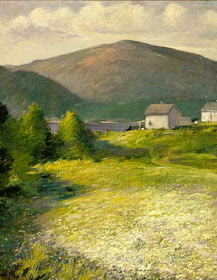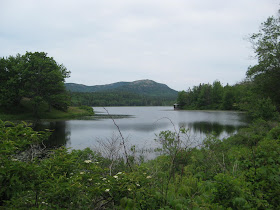The cliffs of Ironbound Island, in Frenchmans's Bay, with the hills of Mt. Desert Island in the background
Maine, thanks to the quality of its remarkable light and scenery, has long had a significant place in American art, particularly and not surprisingly, landscape painting. From Alvan Fisher in the 1830's, to Fitz Henry Lane, Frederick Church and Thomas Cole in the mid 19th century, to John Marin, Marsden Hartley, Rockwell Kent, and Thomas Bellows in the 1930's, to William Kienbusch, Fairfield Porter, and of course, those damned Wyeths, in the 50's and 60's, many of America's best painters have passed through and left a record of our landscape as they saw it. I have long intended to do a series of posts about the artists who have left their mark up here in our part of Maine, Down East of the Penobscot River, and today I offer the first story, about Dwight Blaney of Ironbound Island, and a few of the friends who visited him there.
Bronze bas relief portrait of Dwight Blaney by Bela Lyon Pratt (American 1867-1917). In his hands, Blaney holds palette and brush, and in the background are the cliffs of Ironbound Island.
Dwight Blaney was born in Salem, Massachusetts in 1865. After attending the Chauncey Hall School in Boston, he trained as an architect, and worked for a time as a draftsman in the firm of Peabody & Stearns. Deeply influenced by the impressionists, particularly Monet, on a European trip, Blaney was one of the earliest of the American painters to use the new style.
Dwight Blaney. View from Ironbound Island To Frenchman, Oil on canvas, 1908
After marrying an heiress to the Eastern Steamship fortune, in 1880s, financial constraints were lifted, and Blaney, a convivial man of many interests, was free to pursue these with vigor. He was one of the earliest collectors of American antiques, beginning in the 1880's, and a founder of the Walpole Society, that most exclusive of collecting clubs, whose ranks were to include Wallace Nutting and later, Henry Francis DuPont. He was one of the first to buy and restore an early American house as his country home (in Weston, Massachusetts) His fascination with exploring the shell middens left behind by the ancient Native Americans led to one of the finest collections of artifacts of its day, and which later constituted constituted the first bequest to the new Abbe Museum in Bar Harbor when it opened in the 1920's. After purchasing Ironbound Island, in Frenchman's Bay 3 miles off Bar Harbor as a summer home for his family, he spent the summer of 1904 studying the land snails of the Island. From 1901-1909 he dredged Frenchman's Bay for marine mollusks, eventually identifying 149 varieties. Two of these were new varieties, which were named for him: Tonicella blaneyi (a chiton) and Oenopota blaneyi (a gastropod). In 1904, he studied the land snails of Ironbound, and in 1916, he and Frederick Loomis Brewster, a palenontologist, extricated 23 varieties of mollusks from pleistocene clays on Mt. Desert. He sailed. And, he painted, maintaining a studio on Ironbound in the summer, and the rest of the year at the Fenway Studio in Boston from 1906-1943, a year before his death.
Dwight Blaney. Ironbound Island, Oil on canvas, 1910
Although the idea behind Ironbound Island was an idyllic summer life, without the pressures of fashionable resorts, the Blaneys were nevertheless a wealthy couple with position, and Ironbound was only three miles offshore from Bar Harbor, then at its height as one of the country's most fashionable watering places. The Blaneys partook of the social life there, their presence at parties and as patrons of events duly noted in the Society pages of the New York Times. When the fashionable world came to Bar Harbor, an invitation to Ironbound often followed. and the Blaney's guest book recorded visits by leading society figures, famous writers, a prince (Rainier I of Monaco, who came to see Blaney's famous collection of shells), and most importantly, many of Blaney's fellow artists. And what artists they were. Below a few of the paintings of Ironbound created by Blaney's friends on visits to his magical island:
 |
| Childe Hassam, American, 1859-1935. Sunset, Ironbound Island, Mt. Desert, Maine, 1896 |
William McGregor Paxton, American, 1869-1941. Oil on canvas, 1916. This portrait shows Blaney's younger daughter in front of the drawing room fireplace of the main house on Ironbound, long since burned, with some of Blaney's antiques collection on display.
And there were others, including, in 1920 and 1922, John Singer Sargent, who was visiting his cousin Mary Hale at her Bar Harbor summer home, and no doubt touching base with his many clients and subjects in the summer colony. He went out to Ironbound to stay with the Blaneys for a few days and produced seven paintings and sketches while there, of which these two below offer a seldom seen side of Sargent at rest with friends.
 |
| John Singer Sargent, American, 1856-1925. The Artist Sketching. Watercolor on paper, 1922. This virtuoso portrait is of Dwight Blaney at his easel on the shore at Ironbound Island |
 |
| John Singer Sargent painting aboard the Blaney yacht Irona, off Ironbound, 1922. Notice the umbrella for shade lashed to Sargent's leg. |
Although the main house burned many years ago, the island remains, with other structures, with conservation restrictions, in the hands of the Blaney family, and is private.
Personal History: After Blaney's death, the Dilettante's father, in the market for a boat, happened to go out to Ironbound to look at Blaney's boat, Irona, a classic 38 footer with cabin, and purchased it. On one mid-summer afternoon in 1953, my parents--my mother nine months pregnant---were on that boat when it became clear that perhaps outer Blue Hill Bay was not where they should be. Fortunately, it was a fast boat, and the local hospital is only a few hundred feet from the town dock, so I was not born on Irona, after all Many years later, I chanced to go out to Ironbound twice, once as the guest of a mutual friend of the Blaney's, who had been loaned one of the houses there for a long fall weekend, and again time with another friend who was visiting the Blaney's daughter Elizabeth Cram, then in her 80's. It was a distinct pleasure to have her show me, in the amazing Ironbound guest book, along with sketches by the many famous artists to visit the island, the photos of my father taking away Irona some 35 years earlier.
Yesterday I asked my father about Irona, and he replied, deadpan, 'yes, handsome boat. We had a lot fun with it, your mother and I. Probably would still have it if you and your sister hadn't been such expensive children. Particularly you."
















































